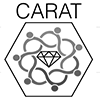Strain engineering of electronic structure in graphene
Grant Agency
Grant Agency of the Czech Republic
Topics
Electrochemical conversion and accumulation of energy.
Year from
2014
Year to
2016
Abstract:
Graphene, atomically thin layer composed of covalently bonded carbon atoms, possesses many unique properties, such as extreme stiffness and strength, high mobility, ballistic transport, superior thermal conductivity, and others. Of all possible applications of graphene, we can name transparent electrodes, solar cells or nanoelectronics. As has been predicted and in part proven experimentally, electronic and ptical properties of graphene can be modified by various means, one of them being local stress fields. Despite a lot of effort exerted towards understanding the response of graphene to mechanical loading, there are still too many opened issues, which demand further research. The aim of this project is to provide a complete picture of mechanically stressed single- or bilayer graphene assessed mainly by transport measurements, in-situ Raman and photoelectron spectroscopies, accompanied by advanced microscopy techniques in order to control its electronic properties by strain. Such knowledge is utterly essential, should graphene be used successfully in its foreseen applications.
Graphene, atomically thin layer composed of covalently bonded carbon atoms, possesses many unique properties, such as extreme stiffness and strength, high mobility, ballistic transport, superior thermal conductivity, and others. Of all possible applications of graphene, we can name transparent electrodes, solar cells or nanoelectronics. As has been predicted and in part proven experimentally, electronic and ptical properties of graphene can be modified by various means, one of them being local stress fields. Despite a lot of effort exerted towards understanding the response of graphene to mechanical loading, there are still too many opened issues, which demand further research. The aim of this project is to provide a complete picture of mechanically stressed single- or bilayer graphene assessed mainly by transport measurements, in-situ Raman and photoelectron spectroscopies, accompanied by advanced microscopy techniques in order to control its electronic properties by strain. Such knowledge is utterly essential, should graphene be used successfully in its foreseen applications.
Mgr. FRANK Otakar Ph.D.
Room
536
Department
Extension
+420 26605 3446
E-mail
otakar.frank jh-inst.cas.cz
jh-inst.cas.cz
 jh-inst.cas.cz
jh-inst.cas.czPublications
















